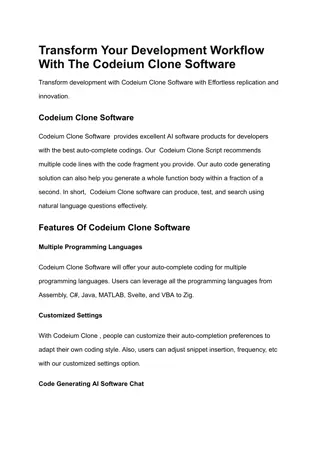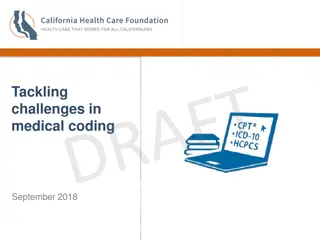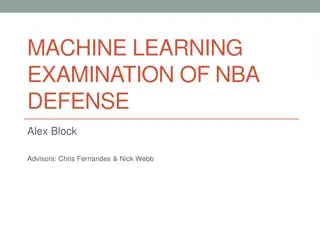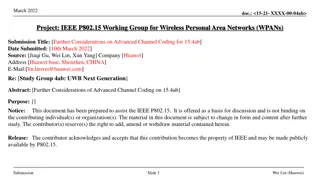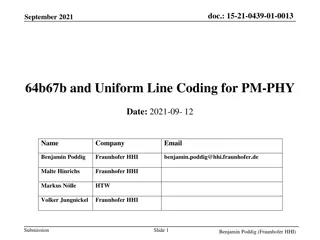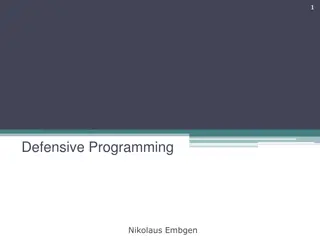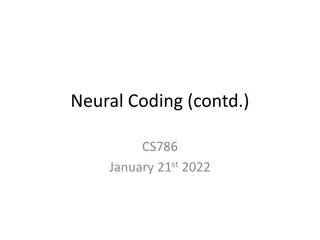
Defensive Coding Techniques for Secure Software Development
Enhance your software security with defensive coding techniques to mitigate risks, prioritize global-minded approaches, understand the importance of complexity, and validate inputs effectively. Follow best practices, know the Tree of Knowledge, and prioritize security in your coding practices to maintain a robust and secure software system.
Uploaded on | 0 Views
Download Presentation

Please find below an Image/Link to download the presentation.
The content on the website is provided AS IS for your information and personal use only. It may not be sold, licensed, or shared on other websites without obtaining consent from the author. If you encounter any issues during the download, it is possible that the publisher has removed the file from their server.
You are allowed to download the files provided on this website for personal or commercial use, subject to the condition that they are used lawfully. All files are the property of their respective owners.
The content on the website is provided AS IS for your information and personal use only. It may not be sold, licensed, or shared on other websites without obtaining consent from the author.
E N D
Presentation Transcript
Engineering Secure Software DEFENSIVE CODING DEFENSIVE CODING TECHNIQUES TECHNIQUES
Defensive Coding vs. Risk Analysis Risk analysis All about domain, assets, threats, what-ifs Global-minded Prioritization is critical Defensive Coding One small change in code big change in risk analysis e.g. storing passwords in the Customer table vs. Users table e.g. website allowing uploading files for one feature Weakest Link mentality Less about prioritization Technology-specific We should always code defensively
Defensive Coding Principles Writing insecure code is surprisingly easy Arcane coding assumptions Many different technologies to know Know thy APIs Misusing an API in the wrong context can be a vulnerability e.g. an XML parser that also executes includes Copying from Internet examples without understanding? For shame. Maintainability still counts Duplicate code is even harder to secure. Vulnerabilities often have regressions and incomplete fixes
Complexity Complexity is the enemy of security Gary McGraw Structural complexity Lots of inter-connected subsystems Architectural complexity Lots of if s & loops Cyclomatic complexity Cognitive complexity Lack of understanding Mistakes (vulnerabilities) How much do I have to think about how this feature works? Subjective, but important Complexity in inputs big security risks e.g. apps to operating systems e.g. pages to web browsers
Know the Tree of Knowledge A lot of defensive coding comes down to clean code and clever tricks Good coding practices CWE Why we do VotD Understanding history tells us what s common, and possible CVE Why we have case studies Makers of any technology understand their own limitations. Read the guidelines provided by originators & experts Many situations don t apply to you, but some very much will Java: http://www.oracle.com/technetwork/java/seccodeguide- 139067.html C++: https://www.securecoding.cert.org/confluence/pages/viewpage.action?pa geId=637
Validating Input Input validation is blockingbad inputs Black list Enumerate the bad stuff Don t allow anything on the blacklist Drawback: infinite, easy to get around Benefit: react quickly (often no re-compilation), straightforward White list Only accept known good input Often done with regex s Drawbacks: Sometimes not possible to block certain characters Often requires re-compilation and patches Recommendation: do both, but prefer a whitelist
Sanitizing Input Instead of blocking input, sanitize it All input comes in, but it s manipulated Convert it to something that won t be interpreted as code Usually utilizes escape characters e.g. HTML < is < e.g. Java is \ Drawback: need to know everything to escape Very blacklist-like False positives are also annoying Need to remember to do it everywhere
Input in Many Forms Not always strings and numbers Consider: images with metadata PHP had many issues with EXIF JPEG metadata Adobe Acrobat & embedded fonts Java with ICC and BMP http://recxltd.blogspot.com/2012/01/bmp-and- icc-standard-tale-in.html http://cve.mitre.org/cgi- bin/cvename.cgi?name=CVE-2007-2789
Exception Handling Most weird, unexpected behavior results in an exception Handle the exceptions you know about Know that sometimes some get away Design your system to handle exceptions E.g. Java catch E.g. JSP <%@ page errorPage="exceptionHandler.jsp" %> For maintainability & complexity: Avoid promoting unnecessarily e.g. throws Exception Deal with related exceptions in one place, near the problem e.g. wrapper around private methods in a class Sheer laziness: try{something();}catch{}
finally Don t forget about the finally clause! Anything in the finally clause gets executed no matter what happens Good for cleanup of resources publicvoid something() { Connection conn = null; try { conn = getConnection(); /* do db stuff */ } catch (SQLException e) { /* handle it */ } finally { DBUtil.closeConnection(conn); } }
Think of the Children Subclassing overrides methods Final keyword: In untrusted API situations, make sure you can t be extended and have a sensitive method overridden publicfinalclass Countdown{}
Prefer Composition to Inheritance entrySet https://www.oracle.com/technetwork/java/seccodeguide-139067.html#4-6 The better approach is to encapsulate a Hashtable inside the Provider
Immutability in OO Prefer immutable value types publicfinalclass MyApi { String myUrl; final String myUrl; public MyApi(String urlString) { // Verify that the URL points to an approved server if (!checkApprovedUrl(urlString) { throw new IllegalArgumentException(); } myUrl = urlString; } } Source: https://stackoverflow.com/questions/15274874/how-does-java-string-being-immutable-increase-security
Constructing Sensitive Objects publicclass ClassLoader { public ClassLoader() { securityCheck(); init(); } } Malicious subclasses can override the finalize() method to resurrect objects
Constructing Sensitive Objects publicclass MaliciousCl extends ClassLoader { staticClassLoader cl; @Override protectedvoidfinalize() { cl = this; } public static void main(String[] args) { try { new MaliciousCl(); } catch (SecurityException e) { } System.gc(); System.runFinalization(); System.out.println(cl); } }
Constructing Sensitive Objects publicclass ClassLoader { private boolean initialized = false; public ClassLoader() { securityCheck(); init(); initialized = true; // Check flag in all relevant methods } }
Getters and Setters can be Dangerous Use Getters and setters only when necessary They don t have to come in pairs Don t just throw getters and/or setters in if you don t have a reason Unnecessarily increases complexity Beans are one exception to this rule Functionality is only get & set Little other functionality Mapping to validation Mapping to relations
Concurrency is Always a Risk Treat anything concurrent with initial distrust Race conditions Denial of Service Shared memory Potential Leakage Weird circumstances Potential Tampering Concurrency is ubiquitous webapps, databases, GUIs, games, etc. Common poor assumptions There will be only one copy of this thread There will only be X threads Nobody knows about my mutability
public static final Global variables are dangerous Mutable global variables are VERY dangerous Increases complexity unnecessarily Tampering concern in an untrusted API Nice try, but still doesn t count: public static final List<String> list = new ArrayList<String>(); public static final List<String> list = new unmodifiableList(asList( Alice , Bob , Charlie ));


